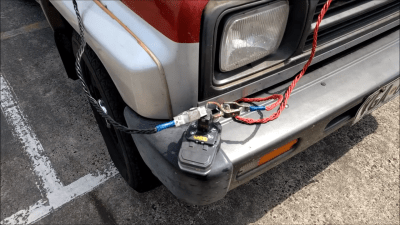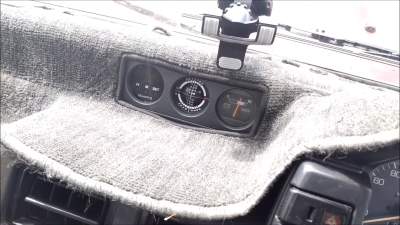How Does Jumping a Dead Nicad Battery Pack Make It Work Again
Sometimes, you lot move to a new city, and things simply aren't going your way. Y'all're out of greenbacks, out of energy, and thanks to your ain foolishness, your auto'due south bombardment is expressionless. You need to jump-start the car, but you're feeling remarkably hating, and you don't know anyone else in boondocks you tin can call. What do you do?
It's not a problem, because you're a hacker and you have a cordless drill in the back seat of your car. The average drill of today tends to run on a nice xviii volt lithium bombardment pack. These packs are capable of delivering large amounts of current and can take a lot of abuse. This is where they come in handy.
Typically, when jump starting a car, another working vehicle is pulled into place, and the bombardment connected in parallel with the dead battery of the disabled vehicle. Ideally, the working vehicle is then started to enable its alternator to provide accuse to the whole organisation to avoid draining its own battery. At this point, the disabled vehicle can be started and its alternator can brainstorm to recharge its own bombardment. After disconnecting everything, you're skilful to become.

Being stuck in a (relatively) strange land and not wanting to speak to anyone, I decided instead to substitute the other vehicle's battery for my RYOBI ONE+ drill bombardment. This presents several challenges and risks, nonetheless. The most basic trouble of all is making a connection. Most drill batteries have a very unique molded connector designed to secure them mechanically into a drill, besides as make electrical contact. Trying to connect a sizable pair of automotive jumper leads to a terminal less than a square centimeter in area is difficult.

Worse, attaching jumper leads to such tiny terminals often puts the positive and negative jumper leads at risk of shorting on each other, which can create sparks or lead to a battery burn or explosion. Be exceedingly careful making the connexion, particularly if you're in a burn down danger area. I was blessed with a truly petite ready of leads which were close to perfect for the task. If your jumper leads are just too big, you might take some luck if y'all can scrounge upwardly some metallic objects or scraps of wire to cram into the terminals to make an adapter of sorts. Meet what yous tin come up upwardly with, but be conscientious doing information technology.
The other major problem is i of voltage. Automotive electrical systems operate nominally at 12 volts; in practice the system sees anywhere from 10-xv volts in apply, due to varying loads and alternator outputs. This is readily visible if your car has a voltmeter installed on the dash. Higher voltages can impairment components in the car's electrical system, particularly in newer cars and those with electronic fuel injection. So how exercise we get away with this? Well, in one respect, sheer dumb luck. I was well enlightened that my bombardment wasvery expressionless – the machine battery was reading less than 10V on the voltmeter. This is below the point at which the bombardment begins to undergo sulfation, which tin can crusade permanent damage. Knowing this, I was confident that my relatively modest drill bombardment (with a chapters of just 2.4Ah) would likely meet its voltage driblet significantly when continued to a load consisting of an well-nigh entirely drained atomic number 82 acid car battery. This is much less likely to exercise damage than if you were to do something intentionally empty-headed like connecting a full 18V drill bombardment directly to delicate components such every bit the ECU. If you're having a adept day, in the brusque-term, y'all'll likely be fine. That said,take this on at your own hazard, and keep in mind that some cars don't similar beingness leap started at all.
The final trouble is one of capacity. If you've got a large, strong drill battery, and a minor compact car, you lot're fairly probable to succeed. I had a medium-sized drill bombardment, at 2.4 Ah, and a 1.vi 50 four-cylinder motor to plow over. Yous're less likely to exist successful trying to turn over a six.nine L Cummins with a half-charged 1.2 Ah drill battery. You lot can e'er give it a get, though.

Well aware of the risks, I decided to press on anyhow, and continued the drill battery to the car battery, ground to ground, positive to positive. Information technology was then every bit simple as turning the key, and with a self-satisfied bark – my engine sprang to life! Success! I was so sure to immediately disconnect the drill battery, lest the alternator dorsum-charge it and cause damage.
Overall, I was remarkably pleased and made it home well in time for supper. What's more, I later threw the drill battery dorsum on charge and it had seemingly sufferedno ill furnishings any! Hopefully this can go y'all out of a tight spot one day – it'due south a useful fox to take in your toolkit!
sharpanambegazzle.blogspot.com
Source: https://hackaday.com/2018/08/16/jump-start-your-car-with-a-drill-battery/
0 Response to "How Does Jumping a Dead Nicad Battery Pack Make It Work Again"
Post a Comment